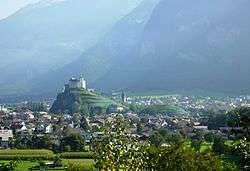Gutenberg Castle
| Gutenberg Castle | |
|---|---|
| Burg Gutenberg (German) | |
 | |
| General information | |
| Type | Castle |
| Location | Balzers, Liechtenstein |
| Coordinates | 47°03′55″N 9°30′00″E / 47.0652°N 9.5001°ECoordinates: 47°03′55″N 9°30′00″E / 47.0652°N 9.5001°E |
| Construction started | around 1100 |
| Owner | Municipality of Balzers and the Principality of Liechtenstein |
Gutenberg Castle (German Burg Gutenberg) is a preserved castle in the town of Balzers, Liechtenstein, the centre of the municipality of Balzers. Gutenberg is one of the five castles of the principality and one of two that have survived preserved until the present day. Unlike Vaduz Castle in Vaduz, Gutenberg Castle does not serve as a residence of the princely family of Liechtenstein and is open to the general public as a museum. The castle lies on a hill near the centre of Balzers and is accessible via a street and road known as Burgweg.[1][2]
Prehistory
The castle hill has been inhabited since the neolithic period. Archeological digs have uncovered several prehistoric artefacts, including the 12 cm (5 in) Mars von Gutenberg figurine, now on display in the Liechtenstein National Museum.[1][3]
History
Gutenberg Castle began its existence as a medieval church and cemetery on a hilltop. In the early 12th century, the cemetery was cancelled and the fortification of the former church structure had slowly began with the addition of a ring wall, forming a simple, roughly circular keep. During the 12th century, several additions followed, in particular the creation of the main tower as a vertical extension of the existing keep. Later on, the tower was outfited with merlons. The first written record of the castle's name comes from 1296. In the 12th and early 13th century, the castle was in the ownership of the lords of Frauenberg, a noble house from the Swiss canton of Graubünden. After the death of Heinrich von Frauenburg in 1314, the castle became the property of the House of Habsburg. It was then used primarily for guarding the borderlands between the local Habsburg-owned territories and the ones belonging to the independent Swiss cantons.
At the turn of the 15th century, the castle underwent extensive new construction works as part of an initiative by Holy Roman Emperor Maximilian I to repair the damage inflicted upon the castle by a siege in 1499, during the Swabian War. Gutenberg Castle possessed a drawbridge until 1537, when the device was damaged by storm and had to be dismantled, never gaining a replacement. During the 17th and 18th century, the castle lost most of its military purpose and was damaged by several fires. It was still being used as a residence around 1750. After a fire in 1795 that greatly damaged Balzers, the castle ruins were used as a source of building material for the reconstruction of the town. The castle was purchased and slightly repaired by the town in 1824, then sold in 1854 to princess Franziska von Liechtenstein.
The castle received a substantial restoration between 1905 and 1912, under the supervision of Vaduz-born architect Egon Rheinberger, its new owner. This restoration added a few new structures and buildings to the lower parts of the castle (see ground plan in references section for more details). After Rheinberger's death in 1936, the castle was rented by the municipality for various events and guests, until it was offered for sale in 1951. In 1979, the castle was purchased by the Principality of Liechtenstein for state and museum purposes. However, the last of the former private owners held her inherited rights to the habitation of the castle until her death in 2001.[4][5][6][7]
Today
The bailey (Vorburg) of the castle is open to visitors free of charge all year round. The castle's chapel and rose garden, reconstructed in 2010, are accessible free of charge every Sunday between 10:00 and 19:00 during the summer tourist season (1 May – 31 October). Guided tours of Gutenberg Castle and its renting for weddings and cultural events are available only during the summer tourist season and need to be arranged in advance by appointment.[1][8][9]
Gallery
 Gutenberg Castle (March 2007)
Gutenberg Castle (March 2007)- Gutenberg Castle (May 2007)
 Balzers, with castle hill in the background (2010)
Balzers, with castle hill in the background (2010)- Close view of the castle hill from Balzers (June 2008)
See also
References
- 1 2 3 "Liechtenstein : The Official Tourism Site - Culture & Cuisine - Places of historical interest : Gutenberg Castle in Balzers". 2013-01-07. Retrieved 2013-01-07.
- ↑ "Photos of Gutenberg Castle". 2013-01-07. Retrieved 2013-01-07.
- ↑ "Article about a visit to the castle". 2013-01-05. Retrieved 2013-01-05.
- ↑ Cornelia Herrmann. Die Kunstdenkmäler des Fürstentums Liechtenstein. Das Oberland. In: Gesellschaft für Schweizerische Kunstgeschichte GSK: Die Kunstdenkmäler der Schweiz. Bern 2007, ISBN 978-3-906131-85-6.
- ↑ "Gutenberg Castle on Burgenwelt.de (in German)". 2016-01-22. Retrieved 2016-01-22.
- ↑ "Ground plan of Gutenberg Castle on Burgenwelt.de (in German)". 2016-01-22. Retrieved 2016-01-22.
- ↑ "History of Gutenberg Castle at the official website of the municipality of Balzers (in German)". 2013-01-10. Retrieved 2013-01-10.
- ↑ "Photo gallery of Liechtenstein and Luxembourg castles, including photos of Vaduz Castle". 2013-01-05. Retrieved 2013-01-05.
- ↑ "Article about Gutenberg castle". 2011-08-26. Retrieved 2013-04-14.
External links
| Wikimedia Commons has media related to Gutenberg Castle. |
- Gutenberg Castle Official Website (in German)